Archaeology and the Bible
Samuel
| Shiloh | 32 03 22.31N 35 17 23.38E | Shiloh stands on a hill, which is where the ruins are to be found. The putative site of the Tabernacle is to the north of the hill, marked by two photographs. |
| Mukhmas | 31 52 19.15N 35 16 37.63E | The Palestinian village preserves the name of Biblical Michmash. The main road to Ai passed through the gorge to the south of the village. The Philistines were probably camped on the level ground to the south-east of the village (near the green symbol) and Jonathan climbed up one of the gullies from the gorge without being seen, to emerge unexpectedly almost in the middle of the Philistine camp. Tilting the 3D view will suggest which one. |
| Gath | 31 41 59.23N 34 50 48.77E | There is a dark line in the south-west quadrant of the circle formed by the dirt road which can be traced running to the right, where it becomes a broader, light streak. This is, I think, the remains of the ditch dug around the hill during a siege, to prevent help reaching the people inside the city. The picture is not clear enough to reveal the excavations or other features of the site. |
| Jerusalem | 31 46 23.40N 35 14 09.73E | The pointer is approximately over the start of the Jebusite Tunnel with the Virgin's Fountain at the foot of the hill to the east. The Ophel Ridge extends south to the rectantle of green, which marks the site of the newly discovered Pool of Siloam. The north-south road to the left of the pointer climbs up the west side of the ridge to run along its summit whereas the next road over to the west follows the course of the Tyropoean Valley. Tilting the 3D view gives an idea of the steepness of the climb from the Kidron Valley but is less clear for the Tyropoean Valley. |
Shiloh
A Danish team supervised by W. F. Albright excavated at Shiloh in the 1920s without making any dramatic discoveries, but the most extensive - and the most exciting - excavations were conducted by Israel Finkelstein in 1981-1984. He found that the site was first settled in Middle Bronze IIA, which he naturally attributed to the Canaanites. Both inside and outside the city he found evidence that the site had been used for what he described as "cultic activities", so he concluded that Shiloh had been a Canaanite sacred site which was taken over by the Israelites.
By the Revised Chronology, however, the people who founded the town in Middle Bronze were the Israelites and it is in this connection that Finkelstein made what is to me his most exciting discovery. Outside the city to the north was an area that had been artificially cleared to create a more or less level platform. Rocks had been cut away to make three sides of a rectangle (the fourth side was open, so although we can say that this artificial platform was 75' wide, we can only say that it was at least 150' long, but may have been longer or shorter) which was aligned east-west.
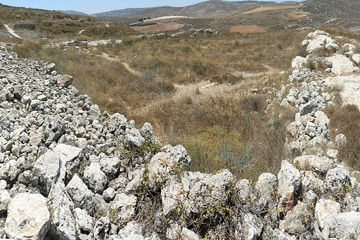
| |
| The stone walls below the tel of Shiloh form three sides of a rectangle the exact size to accommodate the Biblical Tabernacle. |
There was a heap of broken pottery and bones which Finkelstein interpreted as the remains of sacrifices, but as he believed that the Tabernacle must have stood inside the settlement at the top of the hill - which is now nothing but bare rock - he pictured the remains of the sacrifices being carried through the town and thrown over the wall. If so, it would indicate a greater awareness of garbage collection and transport than is evidenced anywhere else in the Middle East - past or present!
According to the measurements given in the Bible, the courtyard which surrounded the Tabernacle was 75' x 150' and the later temple was certainly oriented in an east-west direction, so we presume that the Tabernacle was also arranged in that way. It does seem remarkable that the Canaanites should have gone to all the trouble of preparing a platform just the right size for the much later Tabernacle: a more likely solution is that the Middle Bronze worshippers were not Canaanites at all but Israelites.
Interestingly, although many other kibbutzim embrace Finkelstein's views, the Jews in the illegal settlement of Shilo appear to have no doubts and cheerfully point to the artificial platform as the site of Tabernacle. As they don't accept any Revised Chronology I presume that they simply ignore the chronological difficulties, on the basis that the size of the platform is just too exact to be a coincidence.
In Middle Bronze III the town was surrounded by a massive wall 18' wide and still standing even today to a height of 24' in places. Outside the wall was the usual impressive glacis. By Iron I there was a two storey building near the top of the tel which was being used for cultic purposes and the town appears to have been prosperous, for more than twenty grain silos, in the form of holes dug into the limestone, were found, one of which contained carbonised wheat, for the Iron I town was destroyed in a fire, which Finkelstein interpreted as the destruction of Shiloh following the capture of the Ark by the Philistines.

| |
| Another view of the Tabernacle site at Shiloh. |
It should be noted that the Bible does not actually say that the Philistines destroyed Shiloh. The fact that when the Ark was returned by the Philistines it was kept elsewhere is supposed to imply that the Tabernacle was no longer in existence. On the other hand 1 Samuel 14:3 specifically refers to "the Lord's priest in Shiloh"; it is only later that the sacred centre appears to be at Nob - though the Tabernacle is not specifically mentioned.
My conclusion is that Shiloh was established soon after the Exodus in Middle Bronze IIA and the Tabernacle set up on the platform which was made for it. During the time of the Judges, as security in the land deteriorated, the town was surrounded by a massive wall, but the Tabernacle was specifically left outside the walls because God was believed to be capable of protecting His own house. Shiloh was still a religious centre in the time of Saul but was destroyed - probably the Iron I destruction layer - following his death and the Philistine victory on the hills of Gilboa. By then the Tabernacle had already been removed, possibly to Nob, perhaps because the loss of the Ark had weakened faith in God's willingness or ability to protect the objects associated with His worship.
By the time of David the Tabernacle was set up at Gibeon, a well-defended city, and it appears to have remained there until the time of Solomon, when it was probably transferred to Jerusalem. Interestingly, it would appear that the Tabernacle was not viewed as one, indivisable assemblage of tent and furniture, for 2 Chronicles 1:5 tells us that when David brought the Ark from Kirjath-jearim to Jerusalem, he also brought the brazen altar to Jerusalem, where he had pitched a new tent to cover the Ark, while the old tent and the other sacred objects remained at Gibeon!
Iron Age
There is another indication that the time of Samuel was the dawn of the Iron Age. 1 Samuel 13:19 mentions that the Philistines retained a monopoly on metal-working, which no doubt meant hunting down and killing any Israelite who set up as a smith. The passage appears to contain a contradiction, for one verse says that the Israelites had to go to the Philistines to have their tools sharpened while the next verse states that they were able to sharpen their tools with "a file". (In fairness it should be pointed out that a more modern translation such as the NIV translates verse 20 as a list of prices charged by the Philistines for the sharpening service.) The contradiction disappears if we consider that the Israelites could sharpen or otherwise work the bronze tools which most of the people used, but had to resort to the Philistines for iron tools.
Of course, just because we call it the Iron Age does not mean that people instantly stopped using bronze and other metals. Goliath, whom we may assume to have had the best of weapons and armour, wore bronze helmet and armour and it was only his spear head - and presumably his sword - which was of iron. (Incidentally, the spearhead is said to have weighed 600 shekels, which would have been about 15 lbs depending on the weight of the shekel. That seems an excessive amount for a spearhead if we think of a spear as a throwing weapon. However if we consider it as similar to the Zulu assegai, which is primarily a thrusting and slashing weapon and only incidentally for throwing, then a head a foot or more in length is conceivable. 15 lbs is still more than the average man would wish to wield - but Goliath was not average!)

| |
| The Bronze Age gateway of Megiddo. Notice the timber inserted in the stonework of the block of masonry immediately left of and below the palm tree. |
There are several reasons for the claim. The first and most important is that during the Middle Bronze Palestine experienced unusual peace and prosperity with wide international trade. This would fit well with the Biblical claims concerning Solomon. Furthermore it is difficult to consider a EBIV/MDI Exodus and an Iron Age Monarchy while holding to the 480 year period from the Exodus to Solomon. In addition excavations have revealed significant buildings from the Middle Bronze which match well with what the Bible describes. For example, the Bible recounts that Solomon's temple was built with "three rows of cut stone and one of cedar wood" (1 Kings 6:36) and this is a technique which is attested in the Middle Bronze (but was not unknown at later periods).

| |
| Detail of the wood in the previous picture. I believe that the wood is modern, but the grooves in which it sits are original. Lengths of wood were used to bind the stone-work together; some have suggested that it was used to give walls stability in the event of an earthquake, but the threat of a battering ram is a more likely reason. |
There are, however, important reasons for concluding that the conventional Iron Age date for the monarchy is correct. The main one is that the Assyrians were certainly Iron Age and unless we reject the chronological information in Kings and Chronicles, with all its carefully worked out synchronisms, there is no way to jump from Middle Bronze II for David and Solomon to Iron Age for Ahab. Although there isn't much written material from Palestine in this early period, the little that we do have in the way of seal impressions and so on is also securely dated to the Iron Age.
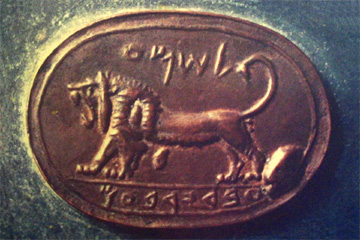
| |
| Seal of "Shema slave of Jeroboam", presumed to be Jeroboam II of Israel. |
To take the most famous example, the inscription in Hezekiah's Tunnel is written in Iron Age style writing and unless we consider it as a memorial inscription put up much later on, we have to conclude that Hezekiah lived during the Iron Age, not the Bronze Age. Another example comes for Megiddo itself: the Schumacher expedition (1093-1905) found a seal which bore the inscription, "For Shema, slave of Jeroboam". As such a finely carved object was certainly not owned by a poor farmer, we conclude that Shema was a wealthy person and royal slaves were commonly wealthy. The stratum in which it was found and the style of writing show that it was too late for the time of Jeroboam I (who in any case was ruler over Judah, not Israel) so it must be Jeroboam II, who reigned around 750 BC.
If we accept that the Israelite monarchy was during the Iron Age, how do we account for the Middle and Late Bronze Ages? The Revised Chronology is based on the assumption that Egyptian chronology is at fault and that up to 600 years needs to be removed from Egyptian history by viewing some of the dynasties as parallel rather than successive. Those excess centuries have to fit between the Twelfth Dynasty, which we believe to be the period of the Exodus, and the Twenty-sixth Dynasty when Pharaoh Necho is positively dated in relation to the Assyrians and Babylonians.
Until the chronology of Egypt has been corrected - if correction is required - it would be foolish for me (or anyone else) to make any definite pronouncements. Various schemes have been proposed: Donovan Courville has worked out how to lose six centuries, David Rohl claims four can be eliminated, I'm not sure what Velikovsky came up with. I don't claim to be an expert in Egyptology, so rather than come up with my own speculations, I prefer to wait and see what the experts finally decide. The only problem is that that final decision may not happen in my lifetime!
The Inspiration of Scripture
That might seem an odd topic to bring up in a book about archaeology, yet archaeology has a bearing on the subject. When I was at college one of the professors posed an interesting hypothetical question: Suppose we were to find a letter by Paul that is not in the Bible and let us further suppose that it could be proved, beyond any doubt, that the letter was indeed by the apostle. Should it be considered part of Scripture or not?
The class was about evenly divided. Those who held that inspiration applies to the book said No. God had compiled (or caused the church to compile) all that was necessary in the Bible and even if a genuine letter of St Paul was found, because it had not formed part of the historical Canon, it could not be admitted. The other half of the class held that inspiration applied to the authors and they said Yes. These men were so filled with the Spirit of God that anything they wrote must be equally inspired - I presume this wouldn't apply to love letters and shopping lists - and therefore the newly discovered letter would have to be admitted to the Canon.
In English translation 1 Samuel 11 reads just fine, but experts in Hebrew tell us that in fact it begins with an incomplete sentence. There is something missing from the start, just as if we were to receive a letter beginning "so he decided to ..." We would immediately consider that we had started on the second page of the letter; what led up to that "so"? However none of the Hebrew manuscripts we have solve the riddle of the missing verse and even the Septuagint, which often contains textual variants, lacks anything that might solve the mystery.
As the Dead Sea Scrolls were translated scholars came across a version of 1 Samuel which contained an extra paragraph that gave background information to the story of Nahash and the city of Jabesh-gilead and supplied the missing half of the sentence.
Nahash, king of the children of Ammon, sorely oppressed the children of Gad and the children of Reuben, and he gouged out all their right eyes and struck terror and dread in Israel. There was not left one among the children of Israel beyond the Jordan whose right eye was not put out by Nahash king of the children of Ammon; except that seven thousand men fled from the children of Ammon and entered Jabesh-Gilead. About a month later Nahash the Ammonite went up and besieged Jabesh-Gilead ...
The question then arose whether that hitherto unknown paragraph should be admitted to the Canon of Scripture. On the whole Bible translators since then have elected not to include this additional information, but one or two have done so. The New American Bible, for example, includes the words "About a month later ..." which do not appear in the Masoretic text, as does the New Century Version, the New Revised Standard and others. It does seem to me that they have fallen between two stools, for by including words which are not in the traditional Canon they have opted for the "inspired person" school, but by not including the complete passage they have still left the text incomplete! So far the New Revised Standard Version is the only one to contain the complete passage.
Michmash
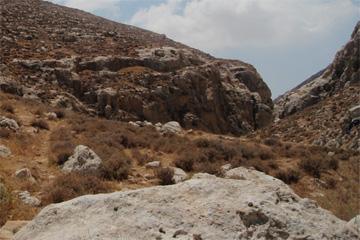
| |
| The gorge below the Palestinian village of Mukhmas. Jonathan would have climbed the rugged slopes to the left. |
Major Gilbert, however, noticed the similarity between "Mukhmas" and the Biblical place-name "Michmash" and re-read the account in 1 Samuel 14, which describes how Jonathan and his armour-bearer climbed between two rocks and surprised the Philistine army. He reported his discovery to General Watson who was sufficiently impressed that he sent out scouts who identified a narrow gap between two rocky crags that might be the "rocks" mentioned in the Bible story.
The plan of attack was duly changed and instead of a brigade-strength frontal assault, a company of infantry climbed the pass between the rocks, surprised the Turks and achieved the desired victory.
The modern Palestinian village of Mukhmas stands to the north of Wadi es-Suweinat at the point where the wadi can be crossed in a north-south direction, as east of the village the sides of the gorge are too precipitous to allow regular traffic such as camel or donkey caravans to pass. To the south of the wadi is Geba - represented today by the Israeli settlement of Givat Binyamin - where Jonathan had attacked the Philistine garrison. The Israelite base was at Gibeah, believed to be Teleil el-Ful.
In response to Jonathan's attack the Philistines occupied Michmash with an army composed largely of chariots, totally unsuitable for the rugged hill country, though doubtless highly effective on the coastal plain which was the Philistine heartland. From Michmash companies were sent out to raid and pillage the countryside. While the camp was thus depleted Jonathan and his companion climbed up the steep hillside from the wadi and attacked the camp guards, who were taken by surprise and fled. Their panic alarmed the raiding parties and a general and disorderly retreat commenced.
Like the modern Palestinians, the Jews had been quiescent in the face of overwhelming strength, but as soon as the first signs of weakness appeared, every man grabbed whatever weapons he could find and the countryside rose against the invaders. The Philistine retreat turned into a rout and to prevent his army disintegrating into a mob intent on looting the Philistine camp - Lawrence of Arabia faced the same problem but without finding a solution - Saul pronounced a solemn curse on anyone who stopped even to eat. Although apparently effective in keeping the army together, the curse backfired when the people became too weak to pursue the fleeing Philistines any further and the Philistines appear to have escaped with their chariots, for there is no mention of them in the account of the victory.
If Teleil el-Ful is indeed ancient Gibeah, excavations show that the site was first occupied during Iron Age I and some time later an impressive fortress was constructed. It is believed that this was Saul's palace-cum-headquarters and was constructed by him when he became king. Today the site is being swallowed up by the Jerusalem suburb of Pisgat Ze'ev.
Goliath of Gath
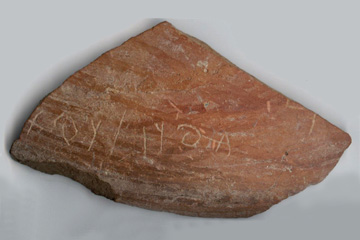
| |
| A potsherd onto which has been scratched two names, both variants on the name "Goliath". |
During the 2005 season someone working in a stratum dating to Iron Age IIA was delighted to discover an ostracon - that is, a piece of pottery on which there was writing. Most ostraca are written on with ink, but in this case the proto-Canaanite letters had been scratched into a piece of pottery typical of the Iron IIA type. When deciphered, the letters proved to spell two variants on the name "Goliath" - 'LWT and LWT (notice the apostrophe; it's important). The excavators were delighted, because Iron II is around the period that both conventional chronology and the Revised Chronology presented here assigns to the story of David and Goliath.
Of course, this does not prove the story of David and the giant champion of the Philistines, it merely makes the story more likely by showing that at the required period, people called "Goliath" lived in Gath. It is even possible that the two similar names provide a solution to an apparent contradiction that has given ammunition to those who claim that the Bible tales have been woven together by a series of singularly incompetent editors whose lack of skill betrayed them to the infallible gaze of German Higher Critics.
According to the well-known story in 1 Samuel 17, Goliath was killed by David with his little sling. However 2 Samuel 21:19 states that Elhanan of Bethlehem killed Goliath of Gath (the KJV tactfully inserts the words "the brother of", which do not appear in any ancient document). Even in Britain I have heard of brothers called "Jack" and "John" - essentially the same name - and it is not impossible that some doting Philistine mother called her two outsize sons 'LWT and LWT, which sounded adequately different when she called them home for tea, but which both transliterated into Hebrew as "Goliath".
The House of David
In view of the paucity of archaeological evidence in Jerusalem noted below, some historians have questioned whether the Bible stories of David establishing a kingdom are true. Archaeologist Israel Finkelstein has been the most prominent of these doubters, claiming that at best David was a tribal chieftan ruling over a petty city state, that Jerusalem was an insignificant village, and so on.
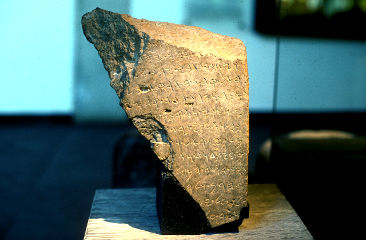
| |
| This part of the "House of David" stele was discovered in 1993. Further fragments turned up the following year. |
In 1993, shortly after Finkelstein had publicised his views (which, incidentally, involve altering chronology by a century), excavators at Tel Dan led by Avraham Biran discovered an inscribed stone which has since become known as the "Tel Dan Stele" or the "House of David Stele". It was the remnants of a stele erected by a king of Damascus and the writing style point to either Hazael or his son Ben Hadad II. That in itself would be interesting enough - a Syrian king erecting a victory stele in one of the important Israelite cities - but in the inscription there is a reference to the "House of David".
And my father lay down; he went to his [fathers]. And the king of I[s]rael penetrated into my father's land[. And] Hadad made me-myself-king. And Hadad went in front of me[, and] I departed from ... [...] of my kings. And I killed two [power]ful kin[gs], who harnessed two thou[sand] [cha]riots and two thousand horsemen. [I killed] [Jo]ram son of [Ahab] king of Israel, and I killed [Achaz]yahu son of [Joram kin]g of the House of David. And I set [...] their land [...] other ... and Jehu ruled over Is[rael.
Hazael's boast that he was responsible for the deaths of Joram and Ahaziah is interesting, for the account in 2 Kings 9 implies that there was more going on in the Israelite army encamped at Ramoth-gilead than is actually stated. Jehu's commanders suspected something, Jehu accused them of knowing the prophet's message in advance, clearly Hazael felt that he had played a part in Jehu's rebellion and certainly there is no record of war between Jehu and Syria!
Nevertheless, interesting as all that is, it is the reference to the "House of David" that has made the stele famous and the centre of a raging controversy. Its discovery was so devastating to the views of Finkelstein and his "Minimalist" school that some (the name Russell Gmirkin springs to mind) actually acused Biran of either forging the stele himself or being a party to forgery! Others have tried to find alternative meanings for the letters "BYTDWD". The trouble is that the word does not occur in isolation: it is linked with "...iah son of ... of the House of David" and in the context the interpretation is clear. "Ahaziah son of Joram of the House of David".
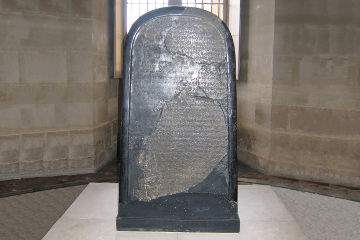
| |
| The Moabite Stone or "Mesha Stele" has been known since 1868 when it was discovered by the Rev F. A. Klein on a pastoral journey to Kerak. |
This means that less than two centuries after David is supposed to have established a ruling dynasty, a Syrian king goes to the trouble and expense to set up a stele in which he boasts of having killed one of the kings of that dynasty. Obviously whatever modern critics may believe, Hazael believed in David!
The year after this discovery - and perhaps influenced by it - the French scholar Andre Lemaire suggested a solution to a puzzle in the Moabite Stone. In line 31 there is a letter missing, damaged when the Arabs broke the stone apart. The complete word is "BT.wD", and the dot indicates the missing letter. Various suggestions have been made, but none of them have satisfied critics. Lemaire proposed that the missing letter is 'D' - "BTDWD" - which would make it "House of David"!
Naturally there was considerable controversy, but Lemaire's suggestion has gradually become accepted, even though it is not without difficulties. That means that there is an even earlier reference to the House of David, little more than a century after the time when David ruled in Jerusalem. In short, although there are problems because of the lack of archaeological evidence in Jerusalem, there can no longer be doubt as to the historical reality of David, King of Israel.
Jerusalem
Archaeologists have not found much in Jerusalem from this period. That is because the Jebusite city stood on what is called the Ophel Ridge, which runs south from the Old City of Jerusalem. Today the ridge is crowded with Palestinian houses and until 1967 the only excavations that could be carried out were in the tiny backyards or courtyards of people were willing to run the risk that something important might be found and they would permanently lose their living space. Since the Israeli occupation of Jerusalem many more digs have been carried out, some of dubious legality, and a number of important discoveries have been made.
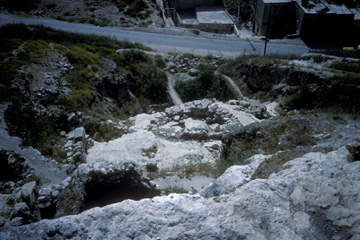
| |
| The circle of stones just above the road (yes, I know that it looks to be below) was discovered by Kenyon and identified by her as the foundations of a Jebusite tower. |
Of the Jebusite period, however, little has so far been found. There is a circle of stones down near the valley floor which is believed to be the remains of a Jebusite tower, there are a few scattered ruins of what may be the city wall, but the most important discovery so far is the Jebusite Tunnel. To appreciate its significance, we must look at the geography of Jerusalem.
The Ophel Ridge slopes steeply down to the Kidron Valley on the east and the Tyropoean Valley on the west. The sides are so steep that the only way to build on them was to construct artificial platforms and these terraces are known as the millo. Keeping the millo in repair was a constant and expensive duty for the rulers in Jerusalem. To the south the Ridge slopes down to the Hinnom Valley and at some point the slope was quarried away to produce a 20' high vertical cliff. Only to the north was the city vulnerable to attack and was, doubtless, defended by a strong wall, but no trace of this has yet been found.
The inhabitants of Jebusite Jerusalem were so confident of their city's strength that they lined the walls to mock David's attempts at conquest and boasted that "Even our cripples will be enough to keep you out!" Unbeknown to them, however, David knew a secret but risky way in and offered the post of commander-in-chief to whichever of his men was the first to enter the city by that route. According to the story, Joab - already commander-in-chief - accepted the challenge and thus retained his post.
It has long been believed that the Warren Shaft, named after the British army engineer Sir Charles Warren, who was the first to explore the length of Hezekiah's Tunnel, was the "gutter" or "hollow" up which Joab climbed. To understand the situation, let me describe a visit to this shaft.
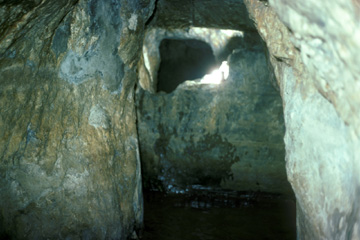
| |
| At this point Hezekiah's Tunnel goes off to the left. As the splash marks show, I climbed over this wall to explore the Jebusite tunnel beyond. |
When I first visited Hezekiah's Tunnel, visitors had to descend a flight of steps from the Kidron Valley to the spring Gihon, locally known as the Virgin's Fountain. After removing your shoes and trousers, you stepped into the swiftly flowing water, ducked under a low doorway and found yourself in a tunnel about 5' in height. After about thirty yards you came to the low wall shown opposite and were obliged to turn sharp left in order to follow the tunnel. Curiosity is my besetting sin, so naturally I clambered over this wall and found myself in a short tunnel. About 8' in the tunnel widened slightly to form a roughly circular chamber, in the roof of which there was a gaping hole leading upwards into darkness.

| |
| The orange glow at the bottom of the shaft comes from the short, blocked off section of Hezekiah's Tunnel described above. |
Although I am no rock climber, the sides of the hole were rough enough and the hole narrow enough that I am confident I could have climbed up it, but the roof of the chamber was about 8' above my head and without a ladder or a couple of hefty friends to lift me up to within reach of the opening, it was not possible for me to even start. There is a report that Warren managed it with the aid of a ladder and a rope. At the top of the 45' shaft he found himself in complete darkness but by crawling around he managed to find a passageway sloping upwards, which he followed on hands and knees. After a considerable distance he noticed a faint gleam of light ahead and was able to stand up. A little further and he found an underground room, the floor of which was littered with empty bottles. The light came from a small opening, through which he was able to squeeze to find himself half-way up the hill in someone's backyard.
Some years later the Israeli Antiquities Authority cleared this long, curving tunnel and opened it to tourists. Known today as the Jebusite Tunnel and shown in the banner at the top of this page, the tunnel led steeply down to the top of Warren's Shaft. It was possible to climb down the modern steps and at the bottom of the tunnel peer down a hole in the rock and see, 45' below, the occasional gleam of light from parties passing through Hezekiah's Tunnel.
Nearby was a second hole in the floor of the Jebusite Tunnel. As described by Dame Kathleen Kenyon, this is a dead end shaft, apparently abandoned when the diggers hit a patch of hard rock through which their tools could not penetrate. They then dug the successful hole known today as Warren's Shaft.
In 1998 further work was done here in connection with a Visitor Centre at the top of the hill and as the work of clearing the hillside was carried out, someone broke through and discovered that there was a short section of tunnel connecting the bottom of the Jebusite Tunnel with the outside. Furthermore, there was another gap in the rock which enabled access from this "lower town" directly to the Virgin's Fountain.
This has led some to suggest that the Warren Shaft is nothing more than a natural fissure in the rock which the builders of the tunnel just happened to encounter and has no significance at all. I must admit that the sides of the shaft are not as smooth or as regular as I would expect for a man-made shaft. Many a pot must have been broken or leather bucket snagged as the Jebusite women lowered it down to fetch water from the pool at the bottom.
Nevertheless, I reject the claim that the shaft is natural. If it was possible to obtain access to the fountain from the lower city, why did someone go to all the trouble of digging a long tunnel from the Fountain to the bottom of the shaft (and how did they know it was there?) and an even longer tunnel from high on the hill to the top of the shaft? These are not casual excavations through loose dirt; they are cut through solid rock and represent an enormous expenditure of time and effort. Even if the shaft is partially natural, the presence of those tunnels at top and bottom is just too much of a coincidence to be natural.
It is, however, possible that by the time of David the direct route had taken the place of Warren's Shaft and that this forgotten "gutter" was the secret way in of which he knew. Access from outside the city to the Fountain was guarded by at least one substantial tower - there may have been a second, but if so its remains are beneath a private house - and most of the risk of the venture may have consisted of sneaking past these watchtowers. Once inside, however, Joab and his men could light a lamp while standing in knee-deep water and then make their way to the shaft and neatly bypass the guards who kept watch on the other exit from the Fountain.
David's Palace
Meanwhile work is going on at the Visitor Centre on the hill above the entrance to the Jebusite Tunnel. A Zionist organisation, the Shalem Centre, is funding exploration on the Ophel Ridge and getting round the objections of the Palestinian inhabitants by simply digging underneath their houses and propping them up on metal poles. Those in charge of the work cynically evade the law by claiming that they are not "digging", they are merely "cleaning" the site.
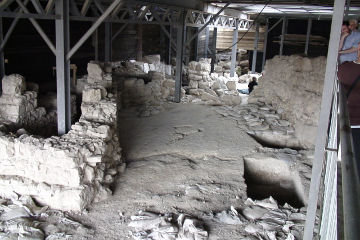
| |
| The Large Stone Structure discovered by Eilat Mazar lies below the flooring of the ticket office to Hezekiah's Tunnel. |
One of those involved in this work is Eilat Mazar, daughter of the highly respected Amihai Mazar, and a competent archaeologist in her own right. In 2005 Mrs Mazar announced the discovery of a large building which she claimed was the palace of King David; others of a more cautious inclination refer to it neutrally as the "Large Stone Structure". Among the finds in the building were a seal of Jehucal son of Shelemiah and a seal-impression of Gedaliah ben Pashur, both of whom are mentioned in the book of Jeremiah. (Jeremiah 38:1)
Unfortunately Mrs Mazar appears to allow her Zionist zeal to override a proper professional caution and in 2008 announced the discovery of a seal which she attributed to a certain Tamah whose family is mentioned in Nehemiah. Other scholars pointed out that seals were carved in reverse so that when they were pressed into clay the inscription appeared the right way round and that some grooves which Mazar had ignored were, in fact, the letter "SH". Mazar was forced to admit that the correct reading was "SLMT", the name "Shelomith" - also mentioned in the Bible, though there is no certainty that the owner of the seal is the same person as the Bible character.
The odd thing is that this "Large Stone Structure" appears to have been built, at least in part, on bedrock, which would imply that it is not a part of the Jebusite city but a new construction outside that city. Other parts of the building are supported by a massive retaining wall first discovered in the 1920s by Macalister and identified by Kenyon as the mysterious "millo" or terracing. If so - and if it is indeed a royal palace - it would explain the reference in 2 Kings 12:21 to the palace as the "House of Millo". David is said to have built the area around the Millo inwards towards the Jebusite city.
Whether or not this is David's palace, it is certainly a large building - some of the walls are 22' thick - and the pottery dates it to the time of David, so it would appear that Finkelstein and the minimalist school are wrong in dismissing David's city as a "mere village".
dawn of the Iron Age One popular version of the Revised Chronology claims that Middle Bronze was the era of the Israelite Monarchy which gradually declined into the poverty of the Late Bronze, and that the Late Bronze "Dark Age" was when the Israelites were taken into captivity in Babylon. I fear, however, that that is to play fast and loose with the evidence.
In the first place, the author of that version cheerfully and approvingly quotes Peter James' Centuries of Darkness in support of the need to reduce the chronology of Egypt - but James' whole argument is that the Late Bronze "Dark Age" never happened! It is a mistake based on an inflated Egyptian chronology. Now if James is right, and the "Dark Age" is a mistaken interpretation of history, then you cannot get rid of the "Dark Age" in Greece and Turkey and Syria and everywhere else, but keep it in Palestine! If the "Dark Age" is a fiction based on a false reading of Egyptian history, then it is a fiction in Palestine as well as elsewhere.
Which, of course, brings me to the second point: the Late Bronze "Dark Age" did not just affect Israel, but affected the whole of the Middle East, yet history is clear that while the Jews were marched off into captivity because of their repeated rebellions against Babylon, the surrounding nations did very well. Even the Bible records the jubilation with which the tribes of Trans-jordan greeted the elimination of Israel and one of the tribes, the Edomites, promptly moved into the Negev and turned it into Idumea (Edomea, if you like).
This, of course, makes sense. It was not in Babylon's interest to totally depopulate the whole of Palestine; who would pay taxes and tribute if there was no one left? So if Phoenicia, Syria and Philistia were all flourishing through the period of Israel's Exile, where is the "Dark Age"? The answer is that if conventional chronology is correct, then there was a "Dark Age" which affected the whole of the Middle East as well as Greece and Turkey; if we accept a Revised Chronology which rejects the idea of a "Dark Age", then there was no "Dark Age" - in Israel or anywhere else. Return
Tel es-Safi There used to be an Arab village on the site, built in and around the remains of the Crusader fortress known as Blanchegarde. In 1948 Shimon Avidan gave written orders to the 51st Battalion "to destroy, kill and expel refugees", allegedly to prevent them fighting the advancing Israelis. Much goes on in the heat of battle that is regrettable, and this order, which today would be considered a war crime, just shows that the Israeli army is no better than any other army. Return
"BYTDWD" Hebrew lacks the word "of" and the relationship is shown by shortening the preceding word; thus to say "house of David" a Hebrew writer would say "hus David". The Hebrew for "house" is is "beth" and some manuscripts indicate the vowel by using the letter 'Y' between the two consonants 'B' and 'TH'. As 'TH' is a single letter in Hebrew, I have indicated this by using the single letter 'T' in the above.
So "BYT" in the Tel Dan Stele and "BT" in the Moabite Stone both mean "house" and by being linked with the following word they are "house of". So far there is agreement among all scholars. "DWD" is certainly how "David" is spelled in Hebrew, but unfortunately it is also how several other words are spelled: "uncle", "lover", even "big pot". Personally I find the suggestion that Hazael killed "Ahaziah son of Joram of the house of the big pot" extremely unlikely, but some scholars, vexed by the idea that the Bible might be correct, claim to find it plausible! Return
the Moabite Stone This inscription is notable for something else: it is the only non-Israelite document to use the sacred Name of God, YHWH. I cannot read Moabite - I struggle with Hebrew! - but I am told that the spelling on the Moabite Stone confirms the vocalisation that is commonly accepted, Yahweh.
The Jews became - and remain - extremely precious about the Divine Name. It is claimed that only the high priest knew how to say it, a secret which he passed on to his son on his death bed. Of course the inevitable happened and some high priest had a heart attack and expired without passing the message on, so the correct pronunciation of God's name was lost.
The common English vocalisation, "Jehovah", is a horrid mishmash of the consonants for "YHWH" and the vowels for "Adonai" (lord) and can be dismissed out of hand. Scholars guessed that it would be something like "Yahweh" and apparently the Moabite Stone confirms this guess.
Obviously we should speak God's name with reverence, but the evidence of the Bible is that the Divine Name was in common use among ordinary people. "As Yahweh lives" was a common oath, the Psalms are full of God's name - "Yahweh is my Shepherd", for example - and the prophets are full of God's Name. There is no need, therefore, for superstition about saying God's name and especially not for the somewhat childish pracice of omitting letters - "G-d" for "God" - in the hope of fooling God into thinking that you aren't really using His Name! Return





